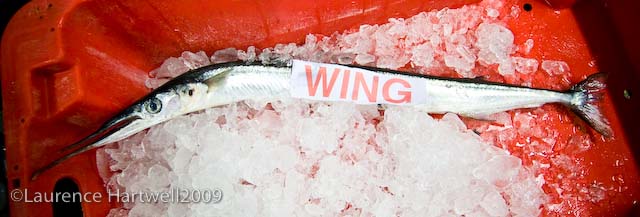With temperature just above freezing there;'s a distinctly misty look to Monday morning in Newlyn...
but that doesn't in any way interfere with the the size and variety of landings on the market, plenty of MSC Ceertified hake from two bog netters, thre Ajax...
and the Stelissa...
also in their landings were a smattering of smoothhounds...
and even some scad...
while the inshore fleet filled the rest of the market with the usual large variety of species associated with the port of Newlyn...
monk tails...
turbot...
big white fish roe...
and of course plenty of quality flats like Dovers, lemons and plaice from the likes of the trawler, Guardian...
along. with every size and type of ray...
more monk...
and a few of these big ling with their distinctive 'goatee' or chin barbel...
the high market price that Dover soles attract means that every inshore trawlerman has a smile on their face when these drop out of the cod end in any quantity...
as do John Dory...
red mullet...
and monk tails...
so more Dovers means more smiles...
likewise, handliners forget the dark, early morning starts and the long hours spent trying to locate fish when these guys start coming aboard...
especially if mackerel are proving elusive....
these dyas the big crabbers are finding more and more Mediterranean octopus in their pots - though they are quite capable of devouring any lobsters that just happen to have found their way through the pot mouth - and in a short space of time too...
nevr without a smile on his face, Mr Smart, the face of auction organisation...
guess the fish...
there were plenty of pollack with the boats that target them...
a fine firm flesh that works well in fish pies or big fillets with simple white-based sauces, saffron being a favourite flavour (and colour) to add...
breakfast-seeking sea gull on take-off...
the lucky ones who find fish head to the market to land, the rest make their way back to a ppontoon berth...
the life of a netter, seemingly, never-ending nets...
tomorrow, is all about how not only young but female fisherman are bolstering the Norwegian fishing industry - in stark contrast to the UK and other nation states.


































